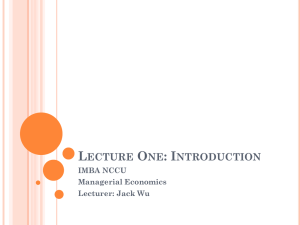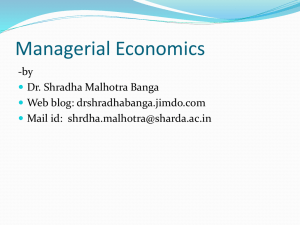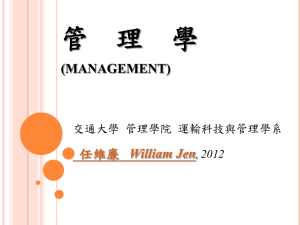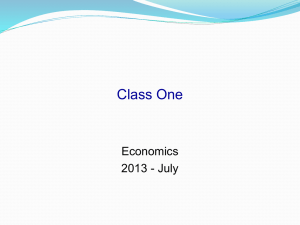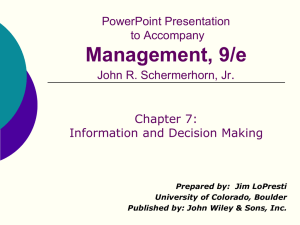Managerial economics
advertisement
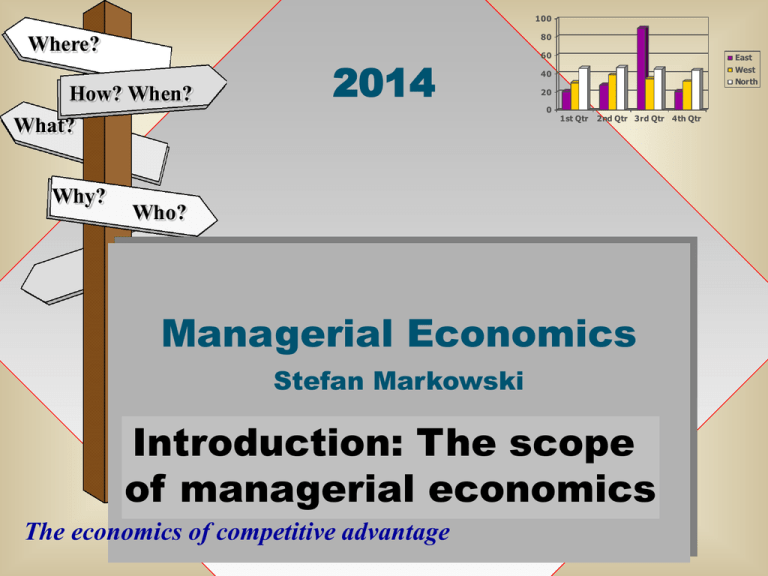
100 80 Where? How? When? What? Why? 2014 60 East West North 40 20 0 1st Qtr 2nd Qtr 3rd Qtr 4th Qtr Who? Managerial Economics Stefan Markowski Introduction: The scope of managerial economics The economics of competitive advantage Course aims • The aim of the course is to apply the basic concepts and principles of microeconomics within the broader framework of organisational management • In particular, the course aims to: – outline economic determinants of managerial decisions under different market conditions, methods of economic analysis, decision support aids and tools and selected economic theories that help managers understand economic processes and structures; and – develop skills needed to analyse links between the firm’s business activities, its external environment and the broader socio-economic phenomena • While the course focuses on managerial decision making in the commercial (private) sector, the application of microeconomic principles in the public sector will also be considered Student learning outcomes • By the conclusion of this course you should be able to: – understand and identify factors impacting managerial decision making; – outline the scope of managerial decision making and the available decision aids; – explain managerial decision under different market conditions; – evaluate the impact of external and internal factors on managerial decision making; – apply managerial decision making tools; and – determine the demand for and supply of the focal firm’s products Detailed course schedule Day no Topic Textbook ch. 1 (24 Nov; 3 hrs) 1. Introduction. Decision making process and its elements. The scope of economic decision making. Application of marginal analysis Chs. 1-2 2 3 3 3 2. Demand analysis and demand elasticities Ch. 3 3. Buyer product valuation and choices. Consumer surplus. Buyer pricing decisions Ch. 4 4 (27 Nov; 2 hrs) 4. Production/transformation process. Production technologies and input-output structure Ch. 5 5 (28 Nov; 2 hrs) 5. Cost structure and cost drivers of producer pricing strategies. Production scale and scope. Chs. 5 and 7 6 (1 Dec; 3 hrs) 6. Structure-conduct-performance. Market structures: competition and contestability. Pricing strategies of buyers and sellers Ch. 8 7 (2 Dec; 3 hrs) 7. Market structures: monopoly/monopsony, monopolistic competition and oligopoly. Pricing strategies and strategic behaviour Chs. 9-10 8 (3 Dec; 3 hrs) 8. Input sourcing and investment. Pricing and market power Chs. 6 and 11 9 (4 Dec; 2 hrs) 9. Decision making under conditions of uncertainty. Informational asymmetries and risk management Ch. 12 10 (5 Dec; 2 hrs) 10. Market research and market analysis. Auction and rings. Strategic behaviour Ch. 13 11 (8 Dec; 2 hrs ) 12 (9 Dec; 2 hrs) 11. Public sector perspective Ch. 14 13 (11 Dec; 2 hrs) Examination (25 Nov; hrs) (26 Nov; hrs) 12. Revision 13. Examination Readings Main reading: M. R. Baye, Managerial economics and business strategy, 7th edition, Irwin/McGraw-Hill, 2010 Focus on managerial challenges rather than economic issues as such. Please note that Microeconomics is specified as a prerequisite of this course Topic 1: The scope of managerial economics Topic Contents 1.1 Economics and economists 1.6 1.2 Why economics is useful to managers Decision making processes and their elements 1.7 Principles of economic interaction 1.8 Principles of decision making Circular flow of economic activity 1.9 Firms and governments Marginal analysis 1.10 Further reading 1.3 1.4 1.5 Managers and the market 1.1 Economics and economists • Economics is the study of how people manage and/or should manage their scarce resources • An economy is a group of people interacting with each other as producers, consumers and traders. It used to have spatial boundaries but it may also be virtual • To understand how it works, economists study/analyse how: – individuals, firms, communities and governments make decisions about scarce resources – economic decision-makers interact with each other – private and social products and outcomes of this interaction 1.1 Economics and economists • Microeconomics is the study of individual (e.g., persons, households, firms) economic behaviour under conditions of scarcity and uncertainty • Macroeconomic is the study of aggregate economic variables such as national income, consumption or investment • Specialised or functional areas of economics application such as growth, development, health or education • Managerial economics is the science (and art) of directing scarce resources to manage more effectively (using economic principles to manage better) 1.2 Why economics is useful to managers • It helps to understand: gains from specialisation and trade economic trade-offs and valuation opportunity cost (opportunities foregone) of production and consumption the nature of substitution and complementarity in economic activities the application of ”thinking at the margin” the nature of economic incentives and disincentives the mechanics of net benefit and profit maximisation market power and how people interact in markets 1.3 Managers and the market • Products/outputs of production activities are validated in output markets – value chains run from downstream (end product) to upstream – cost (supply) chains run from upstream to downstream • Markets for outputs – goods and services (selling/marketing) • Markets for inputs – labour, capital, knowledge, land (sourcing/procurement/hiring/renting) • The discipline of the market - money votes • Market power –the power to set the terms of market exchange 1.3 Managers and the market Value Costs 1.3 Managers and the market 1.3 Managers and the market • Markets comprise clusters of buyers and sellers who try to engage each other to exchange goods and services • Market as an area of opportunity (what, where, why?) • Market as a source of information • Market as a source of seller/buyer power • Market as a source of uncertainty and as risk mitigation mechanism • Market as an economic umpire (winners and losers) 1.4 Principles of decision making • Resources are finite, thus scarce, and should be used economically • Decision-makers face trade-offs and must make choices • Every choice implies opportunity cost • To economise, decision-makers must think at the margin (see below) • Decision-makers usually respond to incentives • Decision-makers should consider the value of time (or time value of money) 1.5 Marginal analysis • To economise, we compare the cost of an incremental (marginal) unit of activity, its marginal cost, with the benefit produced by this increment of activity, marginal benefit • If Marginal Benefit > Marginal Cost, it pays to engage in an activity providing that its Average (or Total) Benefit equals or exceeds its Average (or Total) Cost • Thus, to maximise the Net Benefit (Benefit less Cost) of an economic activity we should engage in it as long as its MB>MC providing that its AB>AC • Max NB when MB=MC and AB>AC or TB>TC 1.5 Marginal analysis Costs and Benefits Total cost, TC MB Max NB loss MC profit/net gain Total benefit, TB loss Optimal scale Volume of output or scale of activity 1.6 Decision making processes and their elements • Production perspective – Scoping (definition/measurement/analysis) – Design – Development – Production – Launch – In-production optimisation/refinement/improvement – Control/evaluation – Decommission • Sourcing perspective – Requirements specification – Acquisition/tendering 1.6 Decision making processes and their elements – Sustainment in-service/use – Disposal – Evaluation • The process of organisational decision making – Organisational planning – Organising – Leading – Monitoring and control – Change management incl. corrective action – Evaluation • In managerial economics we normally use economic models which provide concise description of activities of interest and allow us to analyse options 1.6 Decision making processes and their elements • Example production mgt for six sigma quality 1.7 Principles of economic interaction • Trade can make everyone better off • Markets are usually good for organising economic activity and moving resources to areas of best use • Governments may sometimes improve on the market performance but they could also make things worse • But, institutions of the state are needed to underpin market operations (e.g., produce “money” to trade or create a legal framework to contract business) 1.7 Principles of economic interaction • Distinction between – stocks (quantities of specified items measured at a point in time); and – flows (changes in quantities measured over a period of time) • They can be mixed but should not be confused • Ceteris paribus – “holding other things equal” to examine a change associated with or attributed to the factor being studied independently of changes associated with/attributed to other factors or influences 1.7 Principles of economic interaction • Markets facilitate physical exchange of goods and services and the exchange of property rights • Property rights are the rights established in law to receive the benefits of ownership of a good, service or an asset • For some goods and services ‘marketable’ property rights cannot be economically produced and/or enforced, e.g., positive or negative externalities (re: Topic 11) • Market participants often seek market power to set terms of exchange to favour their interests (re: market structures) 1.8 Circular Flow of Economic Activity Macroeconomic model: Circular flow of economic activity Output Markets Firms/ buyers/ Input Markets sellers/ employers Principle of market exchange: Buying is also selling, e.g., to exchange goods for money is to exchange money for goods People/households/ consumers/investors /savers/employees 1.9 Firms and governments • The nature of the firm • Business objectives – profit – rents – satisfaction • The principal-agent framework – owners/shareholders – managers/employees • Limits of government economic intervention – rationale for intervention: market failure – principal-agent problem – rationale for non-intervention: government failure – excessive government 1.10 Further reading M. R. Baye, Managerial economics and business strategy, 7th edition, Irwin/McGraw-Hill, 2010: chs. 1-3
